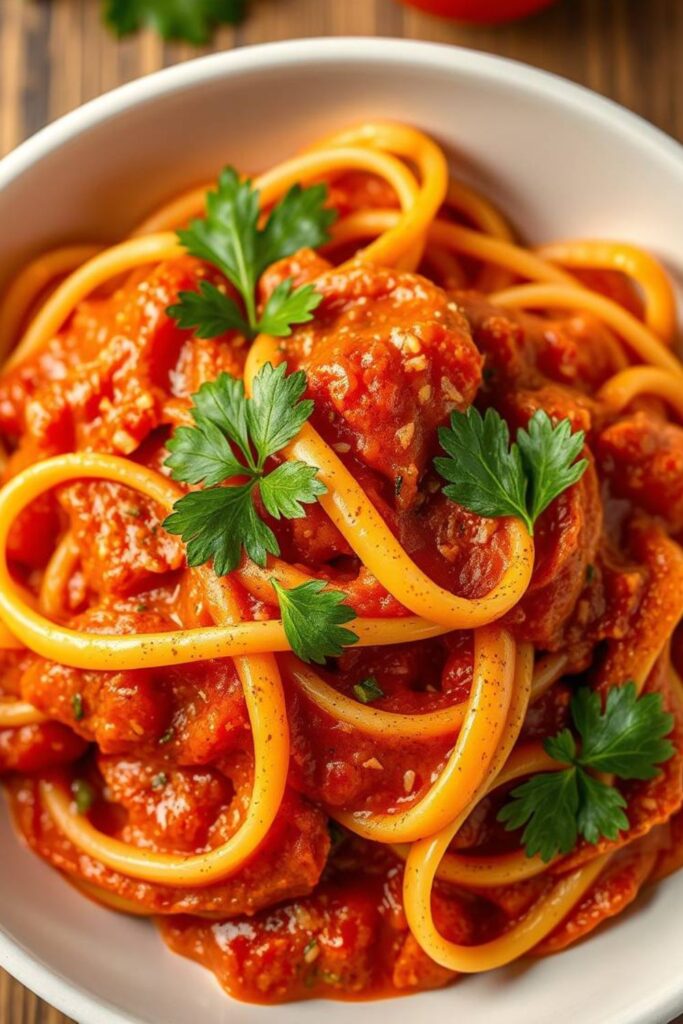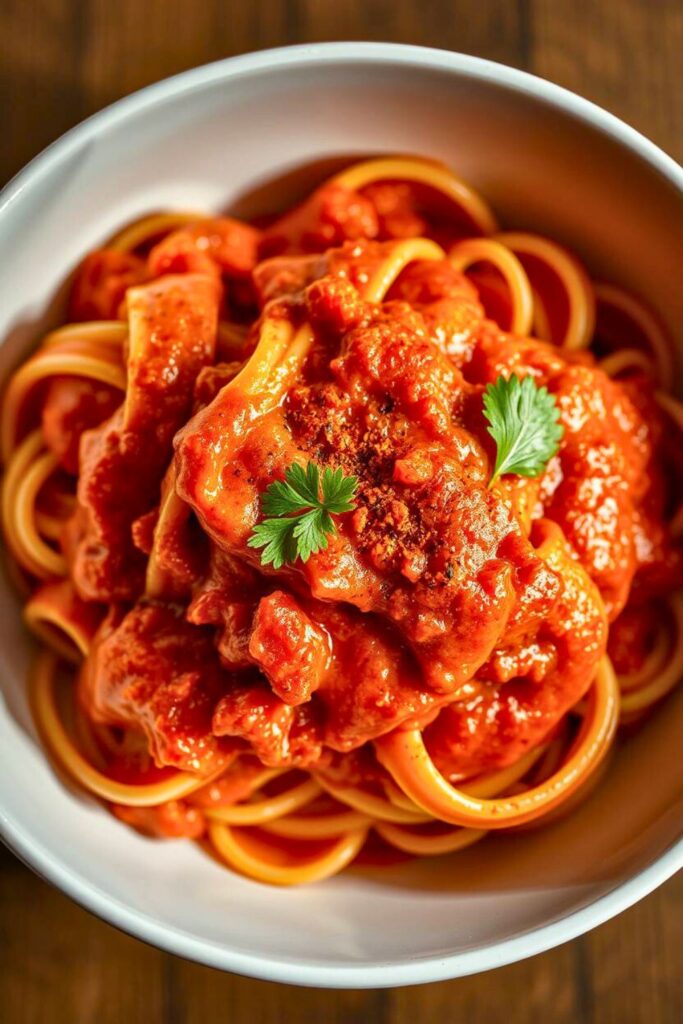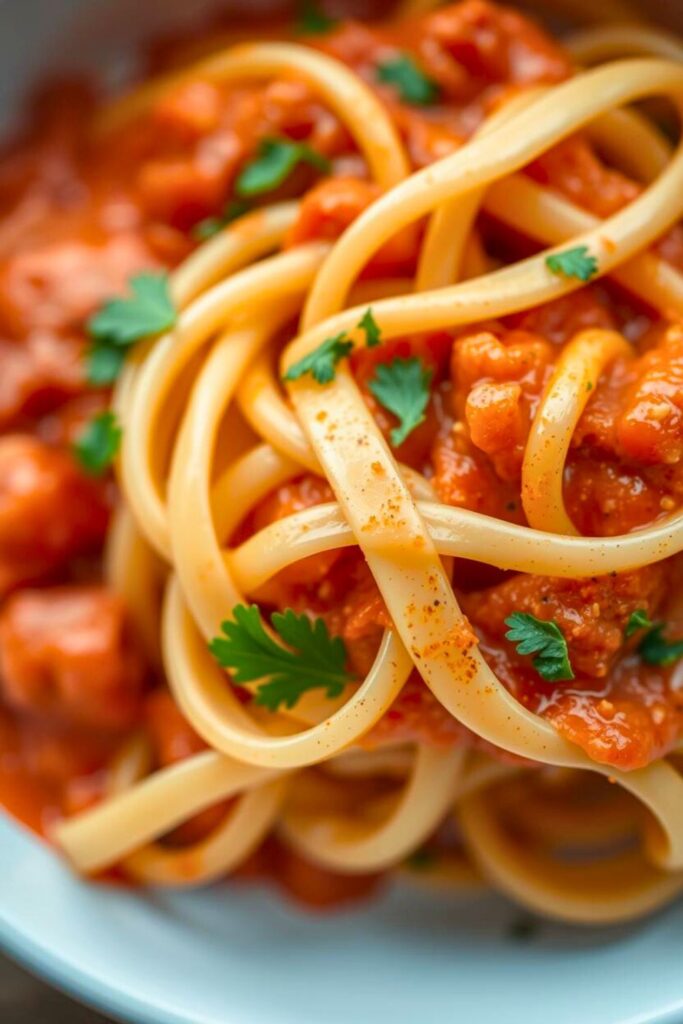Forget everything you think you know about fusion cuisine. The magic isn’t happening in trendy restaurants with celebrity chefs. It’s simmering quietly in home kitchens where grandmothers refuse to let tradition die, even when tradition needs to adapt.
Arabic pasta broke all the rules long before “fusion” became a buzzword. Lebanese families in Detroit, Palestinian cooks in Chicago, Syrian mothers in Montreal. They all figured out the same beautiful secret. You don’t abandon your heritage when you embrace new ingredients. You make them speak your language instead.
This isn’t about authenticity debates or cultural appropriation. Arabic pasta represents something deeper – the brilliant stubbornness of home cooks who looked at Italian noodles and saw endless possibility. They transformed simple pasta into something that tastes like home, no matter how far from home you’ve traveled.
What Makes Arabic Pasta Revolutionary
Arabic pasta doesn’t just combine Middle Eastern spices with Italian noodles. It reimagines comfort food entirely. The warm embrace of seven spice blend. The bright tang of sumac. The way pine nuts add luxury to weeknight dinners. Every element serves a purpose beyond just flavor.
Traditional Arabic cooking builds layers of taste through patience and technique. Arabic pasta carries that same philosophy into weeknight dinner territory. You get complexity without complexity. Sophistication without pretension. Food that feeds both body and soul.
The beauty lies in how Arabic pasta honors both culinary traditions without compromising either. Italian techniques provide structure, proper pasta cooking, sauce emulsification, timing. Arabic flavors provide soul, warming spices, generous hospitality, food as love language.
Essential Arabic Pasta Ingredients & Kitchen Solutions

Building Your Flavor Foundation
Start with what matters most, the protein and aromatics that’ll carry your Arabic pasta to greatness. I’m listing these in cooking order, not alphabetical chaos.
The protein base:
- 1 pound ground lamb (beef works fine too)
- 2 large onions, diced fine
- 6 cloves garlic, minced
- 1/4 cup pine nuts
Your spice arsenal:
- 2 teaspoons seven spice blend (baharat)
- 1 teaspoon ground allspice
- 1/2 teaspoon cinnamon
- Salt and black pepper
Sauce builders:
- 1/4 cup excellent olive oil
- 2 tablespoons tomato paste
- 1 can (14 oz) diced tomatoes
- 1/2 cup rich beef stock
Pasta and finishes:
- 1 pound penne or rigatoni
- 1/4 cup fresh parsley, chopped
- 2 tablespoons sumac
- Feta or labneh for serving
Smart Swaps That Actually Work
Can’t find ground lamb? Beef delivers similar richness. Turkey works if you want leaner. Even a beef turkey mix creates interesting depth for your Arabic pasta.
Seven spice blend missing from your spice rack? Combine equal parts allspice, black pepper, cinnamon, cloves, cardamom, nutmeg, and ginger. Store it properly and you’ll use it everywhere.
Pine nuts cost a fortune in most places. Toasted almonds provide similar crunch and richness. Sunflower seeds work in a pinch. The texture matters more than the specific nut.
Sumac adds irreplaceable tartness to Arabic pasta. Fresh lemon juice at the end provides brightness, though it won’t match sumac’s unique flavor profile.
Your olive oil choice matters enormously here. You’re building flavor, not just preventing sticking. Choose something you’d happily drizzle on good bread.
Step by Step Arabic Pasta Mastery

Getting Your Setup Right
Fill your largest pot with generously salted water. Bring it to a rolling boil. Meanwhile, heat your biggest skillet over medium heat.
Add olive oil until it shimmers. Toss in pine nuts first, they toast quickly and burn faster. Two minutes gets them golden and fragrant. Remove them immediately.
Building the Flavor Base
Keep that flavored oil in the pan. Add diced onions and cook them slowly. Eight to ten minutes of patient stirring transforms them into golden sweetness. Those brown bits forming on the pan bottom? That’s flavor gold.
Add garlic and cook until fragrant, about one minute. The smell should make your neighbors jealous.
Increase heat to medium high. Add your ground meat and resist the urge to stir immediately. Let it sit for two minutes, developing that crucial crust. Then break it up and brown thoroughly.
The Spice Magic
Add your seven spice blend, allspice, and cinnamon to the browned meat. Stir everything together and let those spices bloom for thirty seconds. Your kitchen should smell like Arabic pasta paradise.
Push the meat mixture to one side. Add tomato paste to the empty space and cook it for one minute. This removes any raw taste and concentrates flavor. Stir it into the meat.
Building the Sauce
Add diced tomatoes and stock. Bring to a simmer, then reduce heat to low. Let this bubble gently for fifteen to twenty minutes. The tomatoes break down and flavors meld into Arabic pasta perfection.
Cook your pasta according to package directions minus one minute. Reserve one cup of that starchy pasta water before draining.
The Final Assembly
Add drained pasta directly to your sauce. Toss everything together, adding pasta water gradually until it looks glossy and cohesive.
Stir in most of your parsley and those toasted pine nuts. Taste and adjust seasoning. This is your moment to perfect your Arabic pasta masterpiece.
The Science Behind Perfect Arabic Pasta

Understanding the Techniques
Proper meat browning creates fond, those caramelized bits that add incredible depth to Arabic pasta. Don’t rush this step. High heat and patience create flavor you can’t achieve any other way.
Blooming spices in oil releases their volatile compounds. This makes them more aromatic and potent than just sprinkling them on top. It’s fundamental to Arabic pasta’s complex flavor profile.
Middle Eastern cooking builds complexity through layered techniques. Each ingredient gets its moment to develop fully before joining the next. Onions caramelize, garlic blooms, meat browns, spices toast.
Pasta water contains starch and salt that bind sauce and noodles together. This creates the silky finish that separates restaurant quality Arabic pasta from home cooking disasters.
Cultural Context That Matters
Arabic families embraced pasta because it fed large groups economically. But they didn’t abandon their flavor preferences. They applied traditional techniques to new ingredients with brilliant results.
The emphasis on properly browning aromatics comes from Arabic cooking traditions. So does the generous use of warming spices and the patient layering of flavors. Arabic pasta represents adaptation, not abandonment.
Making Arabic Pasta Beautiful and Memorable
Presentation That Impresses
Serve Arabic pasta in wide, shallow bowls that show off all the components. Deep bowls hide the beautiful textures and colors you’ve worked to create.
Sprinkle sumac generously over each portion. That ruby red powder adds color and bright tartness that cuts through richness perfectly.
Crumble feta or labneh on top for creamy contrast. A drizzle of your best olive oil makes everything shine. Fresh herbs aren’t just garnish, they add essential brightness.
Perfect Pairings
Arabic pasta pairs beautifully with medium bodied red wines. Lebanese blends would be thematically perfect. Côtes du Rhône or Chianti work excellently too.
For white wine lovers, choose something with body. Viognier or richer Chardonnay can handle these bold flavors without getting overwhelmed.
Keep sides simple since Arabic pasta stands alone perfectly. A cucumber tomato salad with lemon dressing echoes Middle Eastern flavors subtly. Warm pita bread helps capture every drop of sauce.
Storage and Reheating
Arabic pasta reheats surprisingly well, though fresh is always best. Store sauce and pasta separately for meal prep. Reheat with a splash of stock or pasta water.
The beauty of Arabic pasta lies in its cultural bridge building. You get pasta’s comfort with Arabic spicing’s warmth. It tells stories of adaptation, creativity, and how flavors transcend borders when treated with respect.
Final Thoughts on Arabic Pasta
Arabic Pasta isn’t just a fusion, it’s a flavorful celebration of Middle Eastern warmth wrapped in the comfort of creamy pasta. With aromatic spices, savory protein, and a touch of richness, it transforms a familiar dish into something boldly unique and deeply satisfying. Whether you’re craving something new for dinner or looking to impress guests with global flair, this dish brings the best of both worlds to your table. One bite, and it just might become your next go to comfort food.
Frequently Asked Questions About Arabic Pasta
Can I make Arabic pasta vegetarian or vegan?
Replace ground meat with diced eggplant or mushrooms for vegetarian Arabic pasta. Cook them exactly like meat, brown them properly for depth. Cooked lentils work beautifully too.
For vegan Arabic pasta, skip the feta and use only olive oil for finishing. The spices and vegetables provide plenty of flavor without any animal products.
What if seven spice blend isn’t available anywhere?
Make your own seven spice for Arabic pasta! Combine 2 tablespoons allspice, 1 tablespoon each black pepper, cinnamon, and ground cloves, 1 teaspoon each cardamom, nutmeg, and ginger. Store airtight for months.
How do I prevent mushy Arabic pasta?
Cook pasta one minute less than package directions suggest. Finish it in the sauce with pasta water. This brings it to perfect al dente while preventing mushiness.
Don’t let combined Arabic pasta and sauce sit too long before serving. Pasta continues absorbing liquid even off heat.
Can I prepare Arabic pasta ahead for entertaining?
Make the sauce a day ahead, it improves with time. Cook pasta fresh though, there’s no shortcut for perfect texture.
Prep all ingredients beforehand for quick assembly. Arabic pasta cooks quickly once you start the process.
My Arabic pasta sauce is too thick or thin, help!
Too thick? Add pasta water or stock gradually until it loosens properly. Too thin? Simmer uncovered to concentrate, or add tomato paste mixed with hot liquid.
Perfect Arabic pasta sauce should coat noodles nicely without being gloppy or watery.

Swiftly Captions by Tina Smith — Quick, flavorful food recipes made simple, bringing fresh inspiration to your kitchen every day





